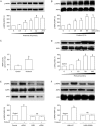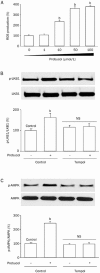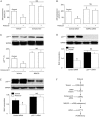Probucol suppresses human glioma cell proliferation in vitro via ROS production and LKB1-AMPK activation
- PMID: 25399650
- PMCID: PMC4261125
- DOI: 10.1038/aps.2014.88
Probucol suppresses human glioma cell proliferation in vitro via ROS production and LKB1-AMPK activation
Retraction in
-
Retraction: Probucol suppresses human glioma cell proliferation in vitro via ROS production and LKB1-AMPK activation.Acta Pharmacol Sin. 2018 Feb;39(2):328. doi: 10.1038/aps.2018.2. Acta Pharmacol Sin. 2018. PMID: 29388569 Free PMC article. No abstract available.
Abstract
Aim: Probucol, an anti-hyperlipidemic drug, has been reported to exert antitumor activities at various stages of tumor initiation, promotion and progression. In this study we examined whether the drug affected glioma cell growth in vitro and the underlying mechanisms.
Methods: Human glioma U87 and glioblastoma SF295 cell lines were used. Cell proliferation was accessed using the cell proliferation assay and BrdU incorporation. The phosphorylation of AMPK, liver kinase B1 (LKB1) and p27(Kip1) was detected by Western blot. The activity of 26S proteasome was assessed with an in situ fluorescent substrate. siRNAs were used to suppress the expression of the relevant signaling proteins.
Results: Treatment of U87 glioma cells with probucol (10-100 μmol/L) suppressed the cell proliferation in dose- and time dependent manners. Meanwhile, probucol markedly increased the ROS production, phosphorylation of AMPK at Thr172 and LKB1 at Ser428 in the cells. Furthermore, probucol significantly decreased 26S proteasome activity and increased p27(Kip1) protein level in the cells in an AMPK-dependent manner. Probucol-induced suppression of U87 cell proliferation could be reversed by pretreatment with tempol (a superoxide dismutase mimetic), MG132 (proteasome inhibitor) or compound C (AMPK inhibitor), or by gene silencing of LKB1, AMPK or p27(Kip1). Similar results were observed in probucol-treated SF295 cells.
Conclusion: Probucol suppresses human glioma cell proliferation in vitro via ROS production and LKB1-AMPK activation, which reduces 26S proteasome-dependent degradation of p27(Kip1).
Figures







Similar articles
-
SIRT1 promotes proliferation and prevents senescence through targeting LKB1 in primary porcine aortic endothelial cells.Circ Res. 2010 Apr 30;106(8):1384-93. doi: 10.1161/CIRCRESAHA.109.215483. Epub 2010 Mar 4. Circ Res. 2010. PMID: 20203304
-
AMPKalpha2 deletion causes aberrant expression and activation of NAD(P)H oxidase and consequent endothelial dysfunction in vivo: role of 26S proteasomes.Circ Res. 2010 Apr 2;106(6):1117-28. doi: 10.1161/CIRCRESAHA.109.212530. Epub 2010 Feb 18. Circ Res. 2010. PMID: 20167927 Free PMC article.
-
Metformin enhances cisplatin cytotoxicity by suppressing signal transducer and activator of transcription-3 activity independently of the liver kinase B1-AMP-activated protein kinase pathway.Am J Respir Cell Mol Biol. 2013 Aug;49(2):241-50. doi: 10.1165/rcmb.2012-0244OC. Am J Respir Cell Mol Biol. 2013. PMID: 23526220
-
AMP-activated protein kinase (AMPK) beyond metabolism: a novel genomic stress sensor participating in the DNA damage response pathway.Cancer Biol Ther. 2014 Feb;15(2):156-69. doi: 10.4161/cbt.26726. Epub 2013 Nov 1. Cancer Biol Ther. 2014. PMID: 24100703 Free PMC article. Review.
-
LKB1/AMPK Pathway and Drug Response in Cancer: A Therapeutic Perspective.Oxid Med Cell Longev. 2019 Oct 31;2019:8730816. doi: 10.1155/2019/8730816. eCollection 2019. Oxid Med Cell Longev. 2019. PMID: 31781355 Free PMC article. Review.
Cited by
-
Renal Protective Effect of Probucol in Rats with Contrast-Induced Nephropathy and its Underlying Mechanism.Med Sci Monit. 2015 Sep 26;21:2886-92. doi: 10.12659/MSM.895543. Med Sci Monit. 2015. PMID: 26408630 Free PMC article.
-
Probucol ameliorates renal injury in diabetic nephropathy by inhibiting the expression of the redox enzyme p66Shc.Redox Biol. 2017 Oct;13:482-497. doi: 10.1016/j.redox.2017.07.002. Epub 2017 Jul 4. Redox Biol. 2017. PMID: 28728079 Free PMC article.
-
Downregulation of LKB1 promotes tumor progression and predicts unfavorable prognosis in patients with glioma.Oncol Lett. 2017 Mar;13(3):1688-1694. doi: 10.3892/ol.2017.5631. Epub 2017 Jan 23. Oncol Lett. 2017. PMID: 28454310 Free PMC article.
-
Reactive oxygen species dependent phosphorylation of the liver kinase B1/AMP activated protein kinase/ acetyl-CoA carboxylase signaling is critically involved in apoptotic effect of lambertianic acid in hepatocellular carcinoma cells.Oncotarget. 2017 Jul 26;8(41):70116-70129. doi: 10.18632/oncotarget.19592. eCollection 2017 Sep 19. Oncotarget. 2017. PMID: 29050265 Free PMC article.
-
CREB1 regulates glucose transport of glioma cell line U87 by targeting GLUT1.Mol Cell Biochem. 2017 Dec;436(1-2):79-86. doi: 10.1007/s11010-017-3080-3. Epub 2017 Jun 23. Mol Cell Biochem. 2017. PMID: 28646353
References
-
- Ricard D, Idbaih A, Ducray F, Lahutte M, Hoang-Xuan K, Delattre JY. Primary brain tumours in adults. Lancet. 2012;379:1984–96. - PubMed
-
- Wong ML, Kaye AH, Hovens CM. Targeting malignant glioma survival signalling to improve clinical outcomes. J Clin Neurosci. 2007;14:301–8. - PubMed
-
- Jansen M, Ten Klooster JP, Offerhaus GJ, Clevers H. LKB1 and AMPK family signaling: the intimate link between cell polarity and energy metabolism. Physiol Rev. 2009;89:777–98. - PubMed
Publication types
MeSH terms
Substances
LinkOut - more resources
Full Text Sources
Other Literature Sources
Miscellaneous

